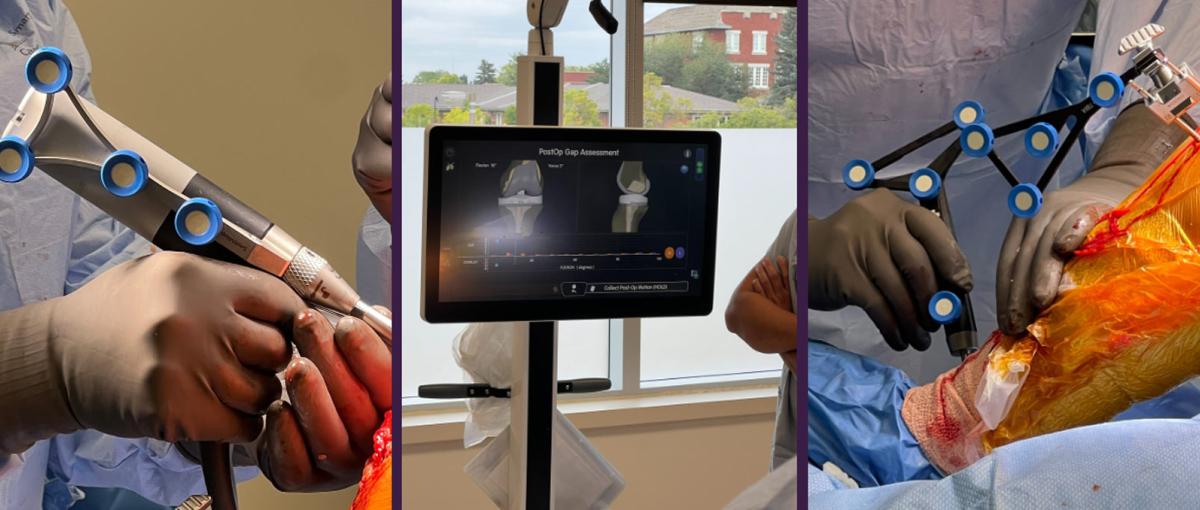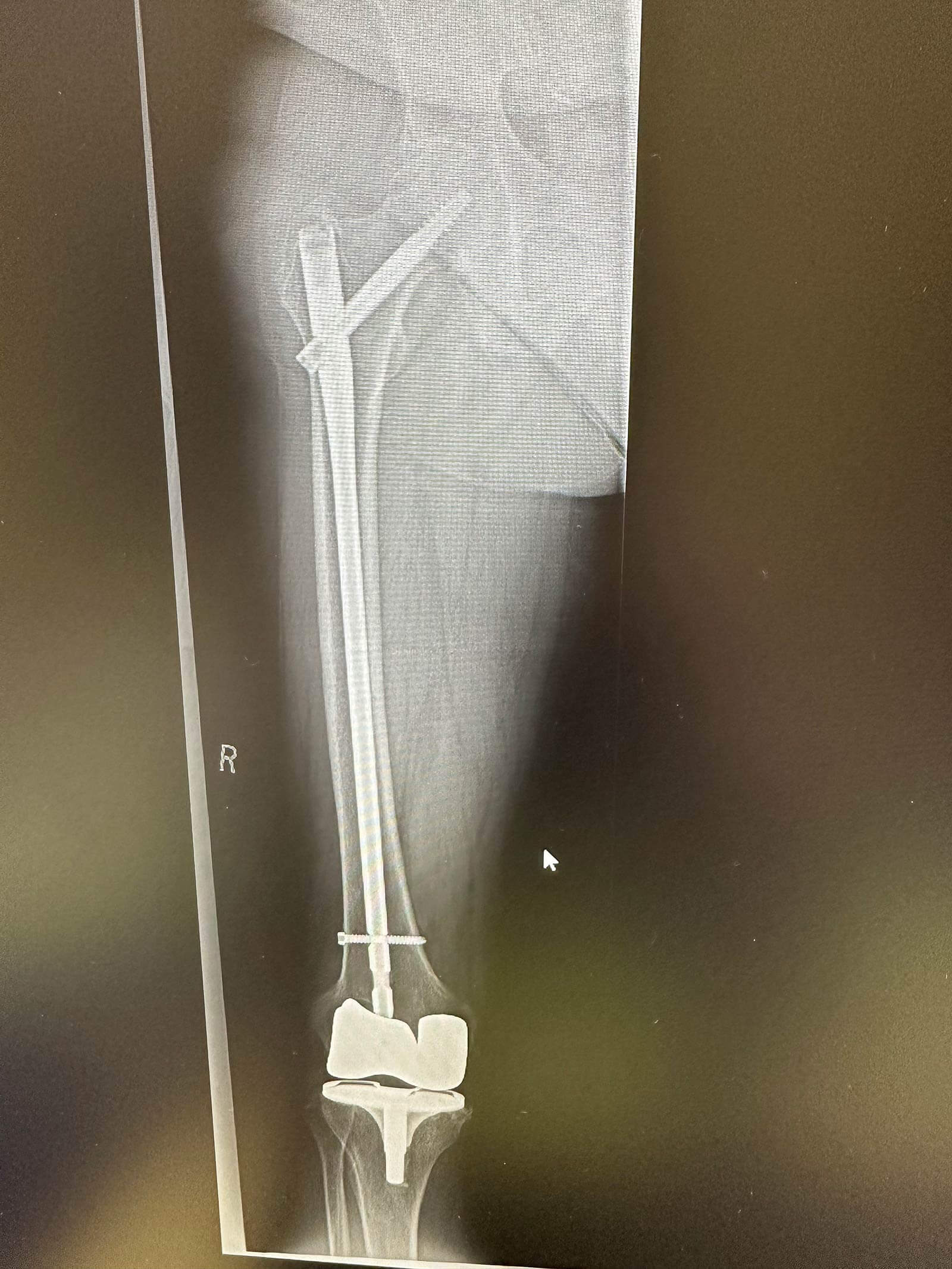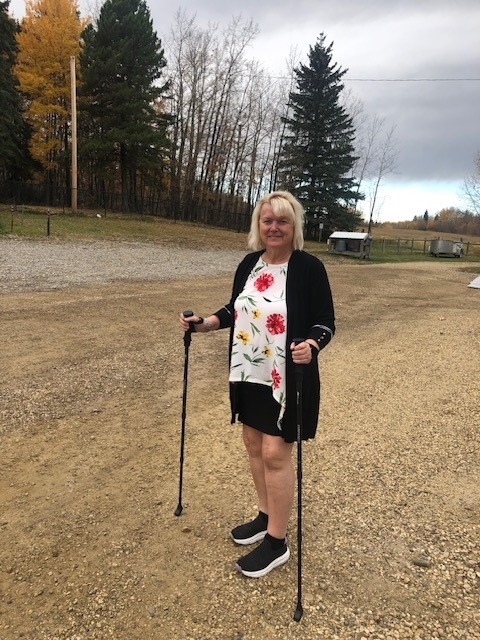Robotic-assisted knee surgery offers patients less pain and quicker recovery

January 16, 2024
By Peter Rybar, social media advisor
Pamela Baxandall needed to have her knee replaced, but she wasn’t sure it could be done with traditional knee replacement surgery. Having fallen off her bike and broken her femur at the hip in 2016, she has a gamma nail in her leg that runs from her hip to her knee. Since removing the gamma nail would increase the risk of another fracture due to osteoporosis, she agreed to have robotic-assisted surgery.
“Everything I read said that it was less invasive and had a faster healing time,” says Pamela.
Robotic-assisted knee surgery is an innovative technique being used with knee replacement patients at St. Mary’s Hospital, a Covenant Health facility in Camrose. It helps surgeons achieve greater precision with bone cuts, better knee balance and better joint alignment than in traditional surgery. And in a case like Pamela’s, it allows them to perform a knee replacement when there is previously existing bone hardware above the knee.

An X-ray shows Pamela’s preexisting bone hardware.
New to Alberta, the surgery was initiated at St. Mary’s by Dr. Sunail Kumar, an orthopedic surgeon who specializes in knee and hip replacements and performs close to 350 surgeries annually. He first learned about the robotic-assisted technique last spring at an industry meeting in Phoenix, Ariz., that he attends annually. Recognizing the technology as a great fit for his clinic, he observed some demonstrations and spent time with a surgeon in nearby Scottsdale to get training and experience.
“I knew this was something we should be doing,” says Sunail.
After undergoing further training at a lab in Pittsburg, Pa., Sunail was ready to bring the robotics technique back to his patients in Camrose. The first 12 cases were done with an engineer on-site, followed by another 12 cases with a robotic-trained company representative.
Now flying solo, Sunail and his team have become proficient with the innovative method. “We’re one of the rare sites in the country that performs these surgeries on our own now, even in complex cases; we’ve gotten very comfortable with it.”
The team is now so comfortable with robotic-assisted surgery that it has become the primary technique used at St. Mary’s.
“Every primary knee replacement case in Camrose is now done using the robotic-assisted technique,” says Sunail. “We are very thankful to Covenant Health and Alberta Health Services for allowing us the opportunity to use it.”
Traditional knee replacement surgery can be difficult to recover from, Sunail says. “Unfortunately, 15-20 per cent of patients are not happy with their total knee replacement. They still experience pain and swelling. Their knee doesn’t feel right, and it doesn’t have the same stability as their other, native knee.”
Using robotic-assisted technology, Sunail and his team can provide patients with better surgical outcomes. Sunail has been impressed with the results he’s seen during follow-up visits at the clinic. “The level of precision from this technique allows for less pain and swelling as well as more stability and quicker recovery.”
As someone who has undergone knee replacement surgery both with and without the use of robotics, Brenda Turner has experienced the difference firsthand.
“It’s been absolutely amazing. My first one did not go well at all. This one was a thousand times better,” Brenda says.
Brenda has been impressed with her recovery following her robotic-assisted surgery. Seven weeks after her operation, she had an almost 120-degree range of motion. “I still don’t have that on my knee from my first surgery. It’s like night and day,” she says.

Brenda Turner takes a walk following robotic-assisted surgery.
Like Brenda, Pamela experienced good results from her robotic-assisted surgery. She encourages anyone considering the procedure to move forward with it. “My recovery has been great,” she says. “I’m swimming and doing lots of walking. It’s getting there.
“I would totally recommend Dr. Kumar and the robotic-assisted surgery because of how precise it is. I’m really happy with everything Dr. Kumar and the hospital staff did for me.”